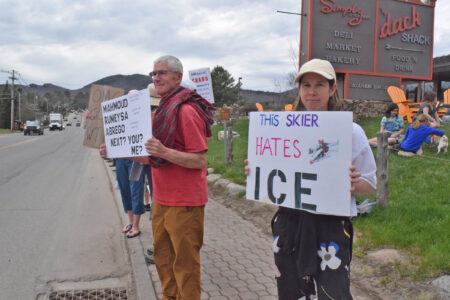Court: EPA dodging Clean Air Act duty
A federal appeals court upheld a lower court’s ruling that the U.S. Environmental Protection Agency made unreasonable excuses for not controlling air pollution that blows across state lines to New York.
The U.S. Court of Appeals for the District of Columbia Circuit issued its decision Tuesday, supporting a lawsuit brought by the states of New York and New Jersey, the city of New York and three environmental groups: the Adirondack Council, the Sierra Club and the Environmental Defense Fund.
New York had asked the EPA to step in because a significant portion of its air pollution came from in upwind states, but the agency delayed and told the state it would have to prove the pollution came from there. When the state offered evidence — including required evidence about how much each pollution control option would cost and how they would help air quality and the environment — the EPA said that wasn’t sufficient. Eventually New York and New Jersey claimed they were getting air pollution from 350 sources in nine states.
The court called the EPA’s response “arbitrary and capricious,” saying, “The EPA’s test, at best, was a moving target and, at worst, demanded likely unattainable standards of proof.”
In cities and suburbs, air pollution leads to human health problems, whereas in the Adirondacks the danger is generally greater to animals and plants. By the 1980s, acid rain from upwind pollution had killed essentially all life in 700 lakes and ponds in the Adirondack Park. The Clean Air Act amendment of 1990 is widely acknowledged as the turning point of reversing that trend, and that is what this case is all about.
Under President Donald Trump, the EPA has generally stepped back from environmental regulation.
“Their agenda is clearly anti-environmental,” Adirondack Council Executive Director Willie Janeway said of the Trump administration. He called it “inexcusable.”
One of Trump’s 2016 campaign promises was to end a “War on Coal,” and his EPA has eased up on enforcing laws that regulate emissions from coal-burning plants. One way the EPA has backed off is by not enforcing the Clean Air Act’s Good Neighbor Provision. Toxins blowing east on prevailing winds from plants in the Midwest pollute air in New York and other states, which are supposed to be able to use the Good Neighbor Provision to have the EPA intervene and tighten restrictions on upwind states and their plants.
For instance, Janeway said, if New York City’s pollution is too high, the EPA could make 36 coal-burning power plants in the Ohio River Valley turn on air scrubbers they already have installed. He said every presidential administration of both major parties has upheld the Good Neighbor Provision since 1990, except Trump’s.
The appeals judges said Trump’s EPA went too far in trying to avoid doing so.
“The EPA offered insufficient reasoning for the convoluted and seemingly unworkable showing it demanded of New York’s petition,” the judges wrote in their decision.
At one point in the ruling the judges called the EPA’s explanation “Delphic,” referring to obscure predictions of the ancient Greek oracle at Delphi.
“This is all quite mystifying,” they wrote. “We are left with no coherent explanation of what was missing from New York’s Petition.”
“You can’t give states the runaround and impose impossible burdens on them and technical requirements that are constantly shifting,” Sean Donahue, a lawyer who represented the Adirondack Council in this case, said Tuesday.
There has been a tug of war for decades between downwind states, which claim to be victims of others’ polluting, and upwind states that claim the downwind states are using the EPA to control them. Donahue said the Good Neighbor Provision “is supposed to be a useful tool for states that have air quality problems, and there’s no dispute that New York and New Jersey do.” He hopes the EPA will take this opportunity to write “more realistic” standards for how states use it.
New York had asked the court to give the EPA 60 days to issue a new decision, but the court chose not to impose a deadline “at this time,” instead saying “we fully expect the EPA to act promptly.”
The EPA’s press office said only that the agency is reviewing the decision.
This ruling follows one in mid May that went a different way in the same federal appeals court — but with different judges. That case was brought by Maryland, Delaware and green groups including the Adirondack Council and Sierra Club. The court ruled that the EPA was within its rights to reject a Good Neighbor petition by Delaware but not another by Maryland. The court ruled that Delaware could keep its air quality within standards without restricting upwind polluters such as Pennsylvania.
Donahue said New York and New Jersey’s case was stronger because they did more extensive research.
New York Attorney General Letitia James issued a statement cheering the victory Tuesday.
“For too long, EPA has ignored its legal responsibility to hold upwind polluters accountable for smog that travels across their borders, and as a result, millions of New Yorkers have been breathing unhealthy air,” she said. “My office will continue to see to it that Trump’s EPA follows the law and fulfills its obligation to downwind states.”
Basil Seggos, commissioner of New York’s Department of Environmental Conservation, said the ruling “sends yet another clear message to Trump’s EPA — quit being cryptic, stop moving the goal posts, and do your job.
“New York has some of the nation’s most stringent air quality rules to protect our communities … But we can’t stop pollution at our borders.”
Donahue added, “This problem only arises if we don’t meet our air quality standards, so obviously the best solution would be to do that instead of waiting until there is a problem. … The general trend has been an improvement long term, but the Trump administration has done a lot of rollbacks, unfortunately, which has made things worse.”
Of all air pollution sources, he said, “Coal plants continue to be dominant. They just pollute so much worse than other sources.”




